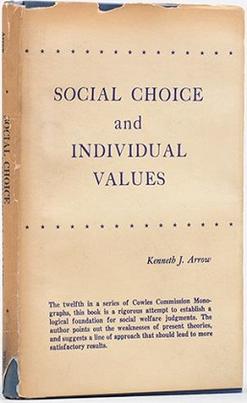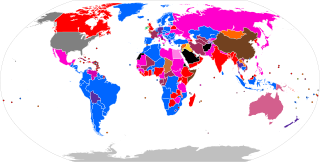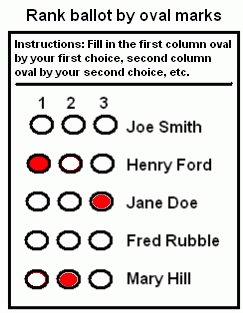
Approval voting is an electoral system in which voters can select any number of candidates instead of selecting only one.
Score voting or range voting is an electoral system for single-seat elections, in which voters give each candidate a score, the scores are added, and the candidate with the highest total is elected. It has been described by various other names including evaluative voting, utilitarian voting, interval measure voting, point-sum voting, ratings summation, 0-99 voting, and average voting. It is a type of cardinal voting electoral system that aims to approximate the utilitarian social choice rule.
Strategic voting, also called tactical voting, sophisticated voting or insincere voting, occurs in voting systems when a voter votes for a candidate or party other than their sincere preference to prevent an undesirable outcome. For example, in a simple plurality election, a voter might gain a better outcome by voting for a less preferred but more generally popular candidate.
Arrow's impossibility theorem, the general possibility theorem or Arrow's paradox is an impossibility theorem in social choice theory that states that when voters have three or more distinct alternatives (options), no ranked voting electoral system can convert the ranked preferences of individuals into a community-wide ranking while also meeting the specified set of criteria: unrestricted domain, non-dictatorship, Pareto efficiency, and independence of irrelevant alternatives. The theorem is often cited in discussions of voting theory as it is further interpreted by the Gibbard–Satterthwaite theorem. The theorem is named after economist and Nobel laureate Kenneth Arrow, who demonstrated the theorem in his doctoral thesis and popularized it in his 1951 book Social Choice and Individual Values. The original paper was titled "A Difficulty in the Concept of Social Welfare".
The independence of irrelevant alternatives (IIA), also known as binary independence or the independence axiom, is an axiom of decision theory and the social sciences that describes a necessary condition for rational behavior. The axiom says that adding "pointless" (rejected) options should not affect behavior. This is sometimes explained with a short story by philosopher Sidney Morgenbesser:
Morgenbesser, ordering dessert, is told by a waitress that he can choose between blueberry or apple pie. He orders apple. Soon the waitress comes back and explains cherry pie is also an option. Morgenbesser replies "In that case, I'll have blueberry."
The Gibbard–Satterthwaite theorem is a theorem in voting theory. It was first conjectured by the philosopher Michael Dummett and the mathematician Robin Farquharson in 1961 and then proved independently by the philosopher Allan Gibbard in 1973 and economist Mark Satterthwaite in 1975, which shows that all ranked-choice voting systems are vulnerable to manipulation by strategic voting.
Bucklin voting is a class of voting methods that can be used for single-member and multi-member districts. As in highest median rules like the majority judgment, the Bucklin winner will be one of the candidates with the highest median ranking or rating. It is named after its original promoter, the Georgist politician James W. Bucklin of Grand Junction, Colorado, and is also known as the Grand Junction system.
An electoral system satisfies the Condorcet winner criterion if it always chooses the Condorcet winner when one exists. The candidate who wins a majority of the vote in every head-to-head election against each of the other candidates – that is, a candidate preferred by more voters than any others – is the Condorcet winner, although Condorcet winners do not exist in all cases. It is sometimes simply referred to as the "Condorcet criterion", though it is very different from the "Condorcet loser criterion". Any voting method conforming to the Condorcet winner criterion is known as a Condorcet method. The Condorcet winner is the person who would win a two-candidate election against each of the other candidates in a plurality vote. For a set of candidates, the Condorcet winner is always the same regardless of the voting system in question, and can be discovered by using pairwise counting on voters' ranked preferences.
The majority criterion is a voting system criterion. The criterion states that "if only one candidate is ranked first by a majority of voters, then that candidate must win."
Positional voting is a ranked voting electoral system in which the options or candidates receive points based on their rank position on each ballot and the one with the most points overall wins. The lower-ranked preference in any adjacent pair is generally of less value than the higher-ranked one. Although it may sometimes be weighted the same, it is never worth more. A valid progression of points or weightings may be chosen at will or it may form a mathematical sequence such as an arithmetic progression, a geometric one or a harmonic one. The set of weightings employed in an election heavily influences the rank ordering of the candidates. The steeper the initial decline in preference values with descending rank, the more polarised and less consensual the positional voting system becomes.

Kenneth Arrow's monograph Social Choice and Individual Values and a theorem within it created modern social choice theory, a rigorous melding of social ethics and voting theory with an economic flavor. Somewhat formally, the "social choice" in the title refers to Arrow's representation of how social values from the set of individual orderings would be implemented under the constitution. Less formally, each social choice corresponds to the feasible set of laws passed by a "vote" under the constitution even if not every individual voted in favor of all the laws.
The later-no-harm criterion is a voting system criterion first formulated by Douglas Woodall. Woodall defined the criterion by saying that "[a]dding a later preference to a ballot should not harm any candidate already listed." For example, a ranked voting method in which a voter adding a 3rd preference could reduce the likelihood of their 1st preference being selected, fails later-no-harm.

An electoral system or voting system is a set of rules that determine how elections and referendums are conducted and how their results are determined. Electoral systems are used in politics to elect governments, while non-political elections may take place in business, non-profit organisations and informal organisations. These rules govern all aspects of the voting process: when elections occur, who is allowed to vote, who can stand as a candidate, how ballots are marked and cast, how the ballots are counted, how votes translate into the election outcome, limits on campaign spending, and other factors that can affect the result. Political electoral systems are defined by constitutions and electoral laws, are typically conducted by election commissions, and can use multiple types of elections for different offices.
Majority judgment (MJ) is a single-winner voting system proposed in 2010 by Michel Balinski and Rida Laraki. It is a kind of highest median rule, a cardinal voting system that elects the candidate with the highest median rating.

The term ranked voting, also known as preferential voting or ranked-choice voting, pertains to any voting system where voters indicate a rank to order candidates or options—in a sequence from first, second, third, and onwards—on their ballots. Ranked voting systems vary based on the ballot marking process, how preferences are tabulated and counted, the number of seats available for election, and whether voters are allowed to rank candidates equally.
Comparison of electoral systems is the result of comparative politics for electoral systems. Electoral systems are the rules for conducting elections, a main component of which is the algorithm for determining the winner from the ballots cast. This article discusses methods and results of comparing different electoral systems, both those that elect a unique candidate in a 'single-winner' election and those that elect a group of representatives in a multiwinner election.
In the fields of mechanism design and social choice theory, Gibbard's theorem is a result proven by philosopher Allan Gibbard in 1973. It states that for any deterministic process of collective decision, at least one of the following three properties must hold:
- The process is dictatorial, i.e. there is a single voter whose vote chooses the outcome.
- The process limits the possible outcomes to two options only.
- The process is not straightforward; the optimal ballot for a voter depends on their beliefs about other voters' ballots.
Combined approval voting (CAV) is an electoral system where each voter may express approval, disapproval, or indifference toward each candidate. The winner is the most-approved candidate.
Highest median voting rules are cardinal voting rules, where the winning candidate is a candidate with the highest median rating. As these employ ratings, each voter rates the different candidates on a numerical or verbal scale.
The Method of Equal Shares is a proportional method of counting ballots that applies to participatory budgeting, to committee elections, and to simultaneous public decisions. It can be used when the voters vote via approval ballots, ranked ballots or cardinal ballots. It works by dividing the available budget into equal parts that are assigned to each voter. The method is only allowed to use the budget share of a voter to implement projects that the voter voted for. It then repeatedly finds projects that can be afforded using the budget shares of the supporting voters. In contexts other than participatory budgeting, the method works by equally dividing an abstract budget of "voting power".







